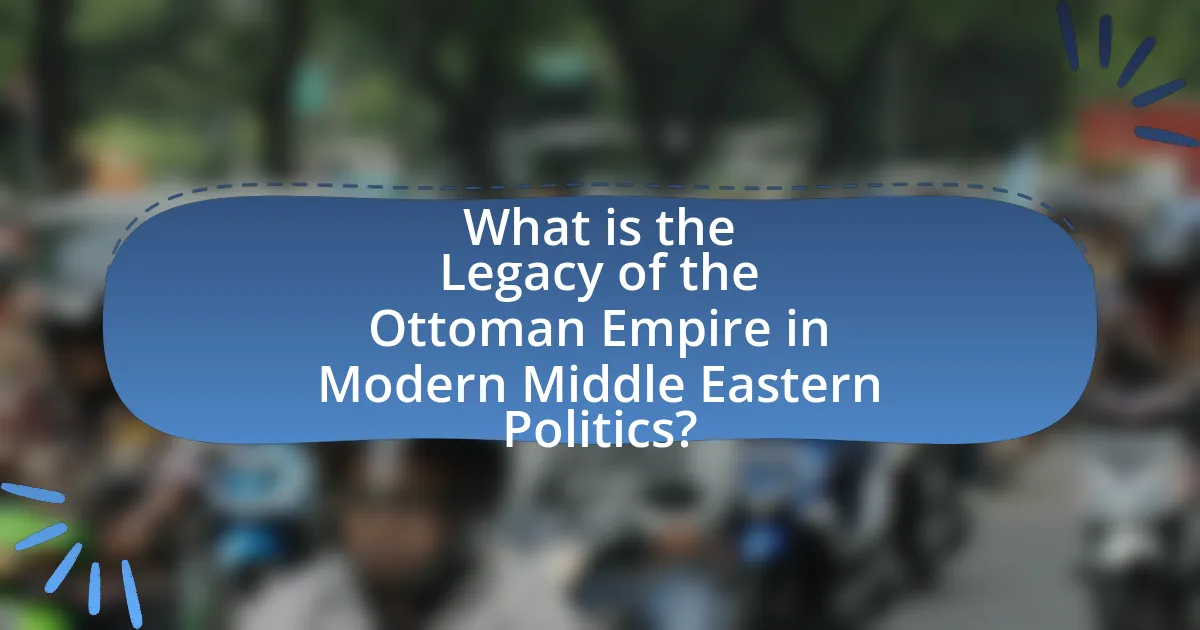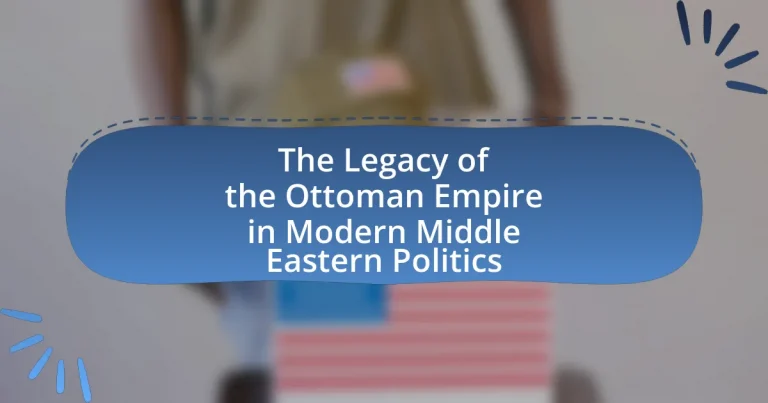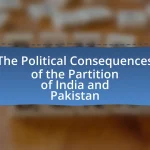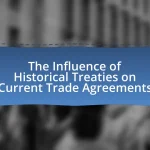The article examines the legacy of the Ottoman Empire and its profound influence on modern Middle Eastern politics. It highlights how the empire’s administrative structures, arbitrary national boundaries, and sectarian divisions have shaped contemporary governance, identity, and conflicts in the region. Key topics include the impact of the Ottoman millet system on sectarian politics, the historical events that led to the empire’s dissolution and the emergence of new nation-states, and the ongoing ethnic and religious tensions that can be traced back to Ottoman policies. The discussion also addresses how contemporary governments reference Ottoman history to legitimize their rule and the implications of this legacy for future political dynamics in the Middle East.

What is the Legacy of the Ottoman Empire in Modern Middle Eastern Politics?
The legacy of the Ottoman Empire in modern Middle Eastern politics is characterized by the enduring impact of its administrative structures, national boundaries, and sectarian divisions. The dissolution of the empire after World War I led to the establishment of new nation-states, often drawn along arbitrary lines that did not reflect ethnic or religious realities, contributing to ongoing conflicts and tensions in the region. For instance, the Sykes-Picot Agreement of 1916 exemplifies how colonial powers divided Ottoman territories, resulting in artificial borders that have fueled disputes, such as those seen in Iraq and Syria. Additionally, the Ottoman millet system, which allowed for religious communities to govern themselves, has influenced contemporary sectarian politics, as seen in the power dynamics between Sunni and Shia groups in countries like Lebanon and Iraq. Thus, the Ottoman Empire’s legacy continues to shape the political landscape of the Middle East, affecting governance, identity, and conflict.
How did the Ottoman Empire influence the political landscape of the Middle East?
The Ottoman Empire significantly influenced the political landscape of the Middle East by establishing a centralized administrative system and promoting a multi-ethnic society. This centralized governance allowed for the integration of diverse ethnic and religious groups under a single political framework, which shaped national identities and political boundaries in the region. The empire’s dissolution after World War I led to the redrawing of borders and the creation of new nation-states, such as Iraq, Syria, and Lebanon, often ignoring ethnic and sectarian divisions. This legacy of arbitrary borders and ethnic tensions continues to impact contemporary Middle Eastern politics, contributing to ongoing conflicts and struggles for national identity.
What were the key political structures established by the Ottoman Empire?
The key political structures established by the Ottoman Empire included the centralized administrative system, the millet system, and the devshirme system. The centralized administrative system allowed the Sultan to maintain control over vast territories through a hierarchy of governors known as beys and pashas, who managed provinces and reported directly to the central authority. The millet system enabled religious communities to govern themselves under their own laws, fostering a degree of autonomy while ensuring loyalty to the empire. The devshirme system involved the recruitment of Christian boys, who were converted to Islam and trained for military and administrative roles, creating a loyal elite known as the Janissaries. These structures facilitated the governance of a diverse empire and influenced modern political frameworks in the Middle East.
How did Ottoman governance affect local power dynamics?
Ottoman governance centralized authority while allowing local leaders to maintain a degree of autonomy, significantly affecting local power dynamics. The empire employed a millet system, which granted religious communities self-governance in personal matters, thereby empowering local leaders and fostering a sense of loyalty among their constituents. This system created a complex relationship where local elites could exert influence while still being subordinate to the central Ottoman authority. Additionally, the appointment of local governors, known as beys or pashas, often relied on local power structures, further intertwining local and imperial interests. Historical evidence shows that this duality allowed local leaders to navigate their roles effectively, balancing allegiance to the empire with their own regional ambitions, which has had lasting implications for modern Middle Eastern politics.
What are the historical events that shaped this legacy?
The historical events that shaped the legacy of the Ottoman Empire in modern Middle Eastern politics include the empire’s expansion and consolidation from the 14th to the 17th centuries, the administrative reforms during the Tanzimat period in the 19th century, and the dissolution of the empire following World War I. The expansion established a diverse multi-ethnic and multi-religious society, which laid the groundwork for contemporary national identities. The Tanzimat reforms aimed to modernize the empire and included legal and educational changes that influenced governance in successor states. The empire’s dissolution led to the creation of new nation-states, such as Turkey, Iraq, and Syria, and the imposition of mandates by European powers, which significantly impacted political boundaries and governance structures in the region. These events collectively contributed to the ongoing political dynamics and conflicts in the Middle East today.
Which major conflicts during the Ottoman period impacted modern politics?
The major conflicts during the Ottoman period that impacted modern politics include the Balkan Wars, World War I, and the Arab Revolt. The Balkan Wars (1912-1913) led to significant territorial losses for the Ottoman Empire and set the stage for nationalist movements in the Balkans, influencing modern national boundaries and ethnic tensions. World War I (1914-1918) resulted in the dissolution of the Ottoman Empire, leading to the establishment of new nation-states in the Middle East, which shaped contemporary political landscapes. The Arab Revolt (1916-1918) against Ottoman rule fostered Arab nationalism and contributed to the eventual creation of Arab states, impacting current political dynamics in the region. These conflicts collectively redefined borders, national identities, and political allegiances, leaving a lasting legacy on modern Middle Eastern politics.
How did the dissolution of the Ottoman Empire lead to new nation-states?
The dissolution of the Ottoman Empire led to new nation-states by creating a power vacuum and enabling nationalist movements among various ethnic groups. Following World War I, the empire’s collapse in 1922 resulted in the division of its territories, primarily through the Treaty of Sèvres in 1920 and later the Treaty of Lausanne in 1923. These treaties recognized the independence of nations such as Turkey, Iraq, Syria, and Lebanon, allowing ethnic groups like Arabs, Kurds, and Armenians to establish their own states. The emergence of these nation-states was driven by the desire for self-determination and the rejection of imperial rule, fundamentally reshaping the political landscape of the Middle East.
What role does nationalism play in the legacy of the Ottoman Empire?
Nationalism significantly shaped the legacy of the Ottoman Empire by fostering the emergence of nation-states in the territories that were once part of the empire. The decline of the Ottoman Empire in the 19th and early 20th centuries coincided with the rise of nationalist movements among various ethnic groups, such as the Arabs, Greeks, and Armenians, who sought independence and self-determination. This desire for national identity and autonomy led to the fragmentation of the empire and the establishment of modern nation-states, such as Turkey, which emerged from the remnants of the Ottoman state following the Turkish War of Independence. The Treaty of Sèvres in 1920 and the subsequent Treaty of Lausanne in 1923 formalized this transformation, recognizing the sovereignty of these new nations and marking the end of Ottoman rule. Thus, nationalism played a crucial role in redefining political boundaries and identities in the region, influencing contemporary Middle Eastern politics and conflicts.
How did Ottoman identity influence the rise of nationalism in the region?
Ottoman identity significantly influenced the rise of nationalism in the region by fostering a multi-ethnic and multi-religious society that later became a basis for national identities. The Ottoman Empire, which lasted from 1299 to 1922, encompassed diverse groups, including Arabs, Kurds, Greeks, and Armenians, each with distinct cultural identities. As the empire weakened in the 19th century, these groups began to seek self-determination, inspired by the Ottoman administrative structure that had allowed for a degree of local governance and cultural expression. The Tanzimat reforms (1839-1876) aimed at modernizing the empire inadvertently fueled nationalist sentiments by promoting ideas of citizenship and rights, which encouraged various ethnic groups to assert their national identities. The eventual dissolution of the empire after World War I further catalyzed nationalist movements, as former subjects sought to establish independent nation-states, drawing on their historical and cultural ties that had been recognized under Ottoman rule.
What are the implications of Ottoman nationalism on contemporary political movements?
Ottoman nationalism has significantly influenced contemporary political movements in the Middle East by fostering ethnic and national identities that challenge existing state boundaries. This nationalism, which emerged in the late 19th century, laid the groundwork for various nationalist movements that sought independence from Ottoman rule, leading to the creation of modern nation-states. For instance, the rise of Arab nationalism in the early 20th century was a direct response to Ottoman centralization efforts, which marginalized local identities. This historical context has resulted in ongoing ethnic tensions and separatist movements, such as those seen in Iraq and Syria, where groups like the Kurds seek greater autonomy or independence. Additionally, the legacy of Ottoman governance continues to shape political discourse, as contemporary leaders often invoke historical narratives to legitimize their authority or to mobilize support.

How does the Ottoman legacy manifest in current Middle Eastern political issues?
The Ottoman legacy manifests in current Middle Eastern political issues through the enduring influence of historical borders, ethnic divisions, and governance structures established during the empire’s rule. The arbitrary borders drawn by colonial powers, which often ignored ethnic and sectarian lines, can be traced back to the Ottoman administrative divisions, leading to ongoing conflicts in countries like Iraq and Syria. Additionally, the sectarian tensions between Sunni and Shia Muslims, rooted in the Ottoman era’s governance, continue to fuel political strife and violence in the region. For instance, the power dynamics in Iraq reflect the historical Sunni-Shia divide, exacerbated by the legacy of Ottoman rule. Furthermore, the centralization of power in the Ottoman Empire has influenced contemporary authoritarian regimes, as seen in countries like Turkey and Egypt, where leaders maintain control through similar governance tactics.
What are the ongoing conflicts that can be traced back to Ottoman policies?
Ongoing conflicts that can be traced back to Ottoman policies include the Kurdish struggle for autonomy, sectarian tensions in Iraq, and the Israeli-Palestinian conflict. The Ottoman Empire’s administrative divisions and policies of millet contributed to ethnic and religious divisions, which persist today. For instance, the Kurdish population, historically marginalized under Ottoman rule, continues to seek greater autonomy in Turkey, Iraq, and Syria. Additionally, the arbitrary borders drawn by the Ottomans laid the groundwork for sectarian strife in Iraq, where Sunni and Shia communities often clash. The Ottoman legacy also influences the Israeli-Palestinian conflict, as the empire’s control over Palestine and subsequent governance issues have shaped national identities and territorial disputes.
How do historical grievances from the Ottoman era affect modern-day disputes?
Historical grievances from the Ottoman era significantly influence modern-day disputes in the Middle East by perpetuating ethnic tensions and territorial claims. For instance, the dissolution of the Ottoman Empire after World War I led to arbitrary borders that ignored ethnic and sectarian divisions, resulting in ongoing conflicts in regions like Iraq and Syria. The legacy of Ottoman governance, which often favored certain groups over others, has left a lasting impact on national identities and inter-group relations, fueling disputes over resources and political power. Additionally, the historical memory of oppression or favoritism during the Ottoman rule continues to shape narratives and justifications for contemporary political actions, as seen in the rhetoric of various nationalist movements in the region.
What role do ethnic and religious divisions play in these conflicts?
Ethnic and religious divisions significantly exacerbate conflicts in the Middle East, often serving as primary fault lines for violence and political instability. These divisions stem from the historical legacy of the Ottoman Empire, which managed a diverse population through a millet system that recognized various religious and ethnic groups but also entrenched identities. For instance, the Sunni-Shia divide has fueled sectarian violence in countries like Iraq and Syria, where political power struggles often align with these religious identities. Additionally, ethnic tensions, such as those between Kurds and Arabs in Iraq, have led to conflicts over autonomy and governance. The ongoing Israeli-Palestinian conflict is also deeply rooted in ethnic and religious identities, with both groups claiming historical and religious ties to the same land. Thus, ethnic and religious divisions not only shape the narratives of these conflicts but also influence the strategies and alliances formed by various groups, making resolution more complex.
How do contemporary governments reference the Ottoman past?
Contemporary governments reference the Ottoman past primarily through cultural revival, political rhetoric, and historical narratives. For instance, Turkey’s government under President Recep Tayyip Erdoğan often invokes Ottoman history to foster national identity and legitimacy, emphasizing the empire’s achievements in governance and culture. This is evident in the restoration of Ottoman-era architecture and the promotion of Ottoman language and traditions in education. Additionally, some Arab states reference the Ottoman past to assert historical claims over territories or to promote unity among diverse ethnic groups, as seen in the rhetoric of leaders in countries like Iraq and Syria. These references serve to connect modern political identities with a shared historical legacy, influencing contemporary governance and regional relations.
What symbols or narratives are used by modern states to invoke the Ottoman legacy?
Modern states invoke the Ottoman legacy through symbols such as the crescent moon and star, architectural styles reminiscent of Ottoman mosques, and narratives emphasizing historical unity and cultural heritage. The crescent moon and star, prominently featured on flags of countries like Turkey and Azerbaijan, symbolize Islamic identity and continuity from the Ottoman period. Architectural styles, including domes and minarets, are often used in public buildings to evoke the grandeur of the Ottoman Empire. Additionally, narratives that highlight the Ottoman Empire’s role in fostering multiculturalism and regional stability are employed to promote national identity and cohesion, particularly in countries like Turkey, where leaders often reference the empire’s historical significance to bolster contemporary political agendas.
How do political leaders utilize Ottoman history to legitimize their rule?
Political leaders utilize Ottoman history to legitimize their rule by invoking the empire’s legacy of governance, cultural achievements, and territorial claims. For instance, leaders often reference the Ottoman Empire’s historical role in unifying diverse ethnic and religious groups under a centralized authority, which they argue provides a model for contemporary state-building and national identity. Additionally, they may highlight the empire’s contributions to art, architecture, and law to foster a sense of pride and continuity with a glorious past. This approach is evident in countries like Turkey, where President Recep Tayyip Erdoğan has emphasized Ottoman heritage to reinforce national unity and assert regional influence, particularly in the context of historical narratives surrounding the Treaty of Sèvres and the establishment of modern borders. Such references serve to strengthen the legitimacy of their governance by connecting current political authority to a revered historical framework.

What are the implications of the Ottoman legacy for future Middle Eastern politics?
The implications of the Ottoman legacy for future Middle Eastern politics include the persistence of ethnic and sectarian divisions, the influence of centralized governance models, and the ongoing territorial disputes rooted in historical borders. The Ottoman Empire’s administrative practices established a framework for governance that many modern states still utilize, which can lead to tensions when addressing diverse populations. For instance, the division of territories post-World War I, as seen in the Sykes-Picot Agreement, has resulted in ongoing conflicts and claims over land, such as those in Iraq and Syria. Additionally, the legacy of Ottoman millet systems, which organized communities by religion, continues to affect political identities and alliances in the region, influencing how states manage minority rights and representation. These historical factors shape contemporary political dynamics, making it crucial for future governance to address the complexities inherited from the Ottoman period.
How might the Ottoman legacy influence future political alliances?
The Ottoman legacy may influence future political alliances by shaping national identities and regional dynamics in the Middle East. The historical governance structures, cultural exchanges, and administrative practices established during the Ottoman Empire continue to affect contemporary political relationships among nations that were once part of its territory. For instance, the Ottoman millet system fostered a sense of communal identity among diverse ethnic and religious groups, which can still be seen in the way these groups negotiate power and form alliances today. Additionally, the historical grievances and territorial disputes stemming from the dissolution of the Ottoman Empire in the early 20th century, such as those between Turkey and Greece or Arab states, may continue to inform diplomatic relations and alliances in the region.
What historical ties could shape regional cooperation or conflict?
Historical ties from the Ottoman Empire significantly shape regional cooperation and conflict in the Middle East. The Ottoman Empire’s administrative divisions and multi-ethnic governance created a legacy of diverse national identities and sectarian divisions, which continue to influence contemporary political dynamics. For instance, the arbitrary borders drawn by colonial powers after the empire’s dissolution in the early 20th century, such as the Sykes-Picot Agreement of 1916, have led to ongoing territorial disputes and ethnic tensions, exemplified by the conflicts in Iraq and Syria. Additionally, the historical dominance of Sunni and Shia sects during the Ottoman era has perpetuated sectarian rivalries, impacting alliances and conflicts among states like Iran, Saudi Arabia, and Iraq. These historical factors contribute to both opportunities for cooperation, such as shared cultural heritage, and sources of conflict, as seen in the ongoing struggles for power and influence in the region.
How can understanding the Ottoman past inform current diplomatic strategies?
Understanding the Ottoman past can inform current diplomatic strategies by highlighting historical patterns of governance, ethnic relations, and territorial disputes that continue to influence modern Middle Eastern politics. The Ottoman Empire’s multi-ethnic and multi-religious structure necessitated a complex approach to governance, which can guide contemporary diplomats in addressing similar diversity within nations like Iraq and Syria. For instance, the empire’s millet system allowed various religious communities to govern themselves, suggesting that modern states might benefit from decentralized governance models to accommodate diverse populations. Additionally, the legacy of territorial divisions established during the Ottoman period, such as the Sykes-Picot Agreement, continues to affect national borders and identity politics today, indicating that understanding these historical contexts is crucial for effective conflict resolution and peacebuilding efforts in the region.
What lessons can be learned from the Ottoman Empire’s political legacy?
The Ottoman Empire’s political legacy teaches the importance of administrative diversity and centralized governance. The empire successfully managed a vast and culturally diverse territory by implementing a millet system, which allowed various religious and ethnic groups to maintain a degree of autonomy while still being governed under a central authority. This approach facilitated social cohesion and stability, demonstrating that accommodating diversity within a unified political framework can lead to effective governance. Historical evidence shows that the millet system contributed to the empire’s longevity, lasting over six centuries, which underscores the effectiveness of inclusive governance in maintaining order and loyalty among diverse populations.
How can modern states avoid the pitfalls of past governance models?
Modern states can avoid the pitfalls of past governance models by implementing inclusive political frameworks that prioritize representation and accountability. Historical examples, such as the centralized authority of the Ottoman Empire, demonstrate that exclusionary practices can lead to unrest and fragmentation. By fostering democratic institutions and encouraging civic engagement, modern states can mitigate the risks of authoritarianism and sectarianism, which have plagued many regions influenced by Ottoman governance. Furthermore, adopting decentralized governance structures can empower local communities, reducing the likelihood of conflict and promoting stability, as evidenced by successful governance models in countries that prioritize local autonomy.
What best practices can be derived from the Ottoman experience in managing diversity?
The best practices derived from the Ottoman experience in managing diversity include the implementation of a millet system, which allowed various religious and ethnic communities to govern themselves under their own laws while remaining loyal to the empire. This approach fostered a sense of autonomy and respect for cultural differences, leading to relative stability and coexistence among diverse groups. Historical evidence shows that the millet system enabled the Ottoman Empire to maintain control over a vast and varied population, with over 20 different ethnicities and numerous religious sects coexisting, thus demonstrating the effectiveness of decentralized governance in managing diversity.
What strategies can be employed to address the challenges posed by the Ottoman legacy?
To address the challenges posed by the Ottoman legacy, strategies such as promoting inclusive governance, fostering interethnic dialogue, and implementing educational reforms can be employed. Inclusive governance can mitigate sectarian tensions by ensuring representation of diverse groups, as seen in post-Ottoman states like Turkey, where political reforms aimed at inclusivity have been crucial. Fostering interethnic dialogue can help heal historical grievances, exemplified by initiatives in countries like Lebanon, where community-based programs have aimed to bridge divides. Educational reforms that emphasize a shared history and multiculturalism can cultivate a sense of unity, as demonstrated in various post-colonial contexts where curricula have been revised to reflect diverse narratives. These strategies collectively aim to reconcile the historical complexities of the Ottoman legacy with contemporary political realities.
How can policymakers engage with historical narratives to foster reconciliation?
Policymakers can engage with historical narratives to foster reconciliation by actively incorporating diverse historical perspectives into policy discussions and educational initiatives. This approach allows for a more nuanced understanding of past grievances and shared histories, which is essential for building trust among conflicting groups. For instance, recognizing the Ottoman Empire’s complex legacy in the Middle East, including both its contributions to cultural exchange and the conflicts it engendered, can help communities acknowledge their intertwined histories. Research indicates that inclusive historical narratives can reduce tensions; a study by the International Crisis Group highlights that educational programs emphasizing shared histories have successfully mitigated ethnic conflicts in post-conflict societies. By prioritizing these narratives, policymakers can create a foundation for dialogue and mutual understanding, ultimately promoting reconciliation.
What role does education play in reshaping perceptions of the Ottoman past?
Education plays a crucial role in reshaping perceptions of the Ottoman past by providing a structured framework for understanding historical events and their implications. Through curricula that include diverse perspectives on the Ottoman Empire, educational institutions can influence how students interpret its legacy, fostering a more nuanced view that contrasts with traditional narratives. For instance, studies have shown that when students engage with primary sources and critical analyses of Ottoman history, they are more likely to appreciate its complexity and relevance to contemporary issues in the Middle East. This shift in perception is essential for addressing historical grievances and promoting dialogue in modern political contexts.


